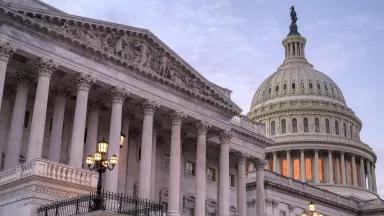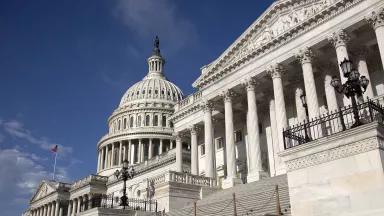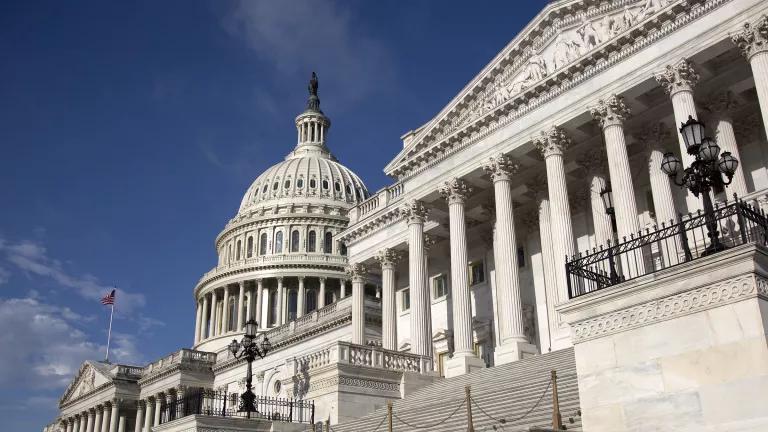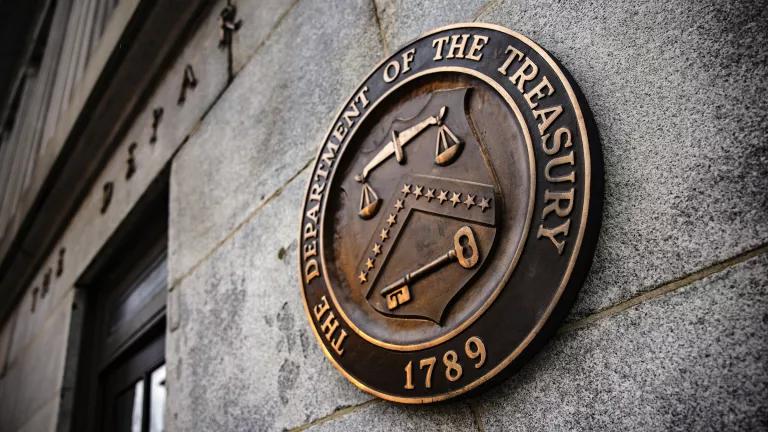Funding the Government for FY2024, Part 2: Calamity in the House
In part 2, I review the shoddy work of the House of Representatives.
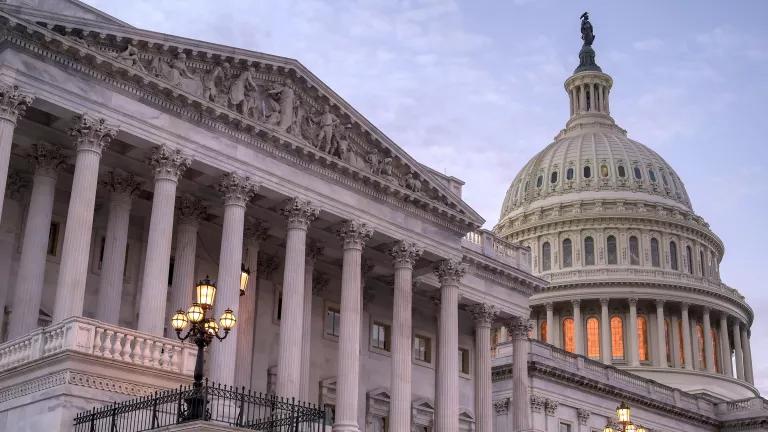
iStock
It’s time for my annual accounting of how the federal appropriations process is playing out. The short answer: One house of Congress is doing the work…while the other is falling flat on its face. This does not bode well for keeping the federal government’s lights on, but there still is hope that disaster can be averted.
Note that this blog has three parts. Part 1, where I summarize the overarching state of play in the government funding space, precedes this part 2, which looks at the shoddy work of the House of Representatives. I close out by examining the more respectable work of the Senate before discussing potential next steps in part 3.
Thanks for hanging in with me thus far! When we last left off, I had just finished setting out the many difficulties surrounding the funding of the federal government for FY2024. I now turn to the efforts that have taken place to that end to date in the House of Representatives. Sadly, the “People’s House” has not acquitted itself well. Let’s get to it.
In the House
The House of Representatives is a sorry shadow of the robust cradle of legislative ideas it was in times past, and its once-revered Committee on Appropriations is no exception. Let’s start with the most outrageous development in the House. As discussed in part 1, the House majority was responsible for exploiting the approach of the debt limit to impose the awful spending caps that will hinder the appropriators for the next two fiscal years (along with many of the other dreadful policy ideas carried in the debt limit legislation). So, what did the majority members do shortly after the debt limit law was enacted? They threw it out the window!
How, you ask? By immediately declaring that the very caps they had just negotiated were too high and insisting upon drafting the bills to even lower numbers. This, of course, rendered all of the appropriations measures as nonstarters to both the Senate and the president, ensuring that they would not be taken seriously. But why stop there? Perhaps realizing that it was already engaged in a pointless endeavor, the majority doubled down on its nonsense by larding its efforts with horrific policy riders, many of which would not be supported by even a bare majority of the House if they were ever put forward for a vote (and most of them won’t be). This is as absurd as it sounds, and it begs the question: Why is this happening? To answer that, let’s take a step back from the appropriations process for a moment.
We all witnessed the humiliating election of the Speaker of the House in January. Some may have looked on in horror, others with schadenfreude, but there is one fact that was laid bare by that Sisyphean farce: The present House majority is scarcely able to govern itself, let alone the country. It is, at a minimum, three ideological groups in one: There is a small, often outflanked, always exasperated cadre of “centrist” members from moderate districts; a small (but growing) cabal of extremists who comprise the party’s right wing and cling to their wrongheaded positions with a pseudo-religious fervor; and a large, soft center that keeps its collective head low and blows with the wind. This Frankenstein’s monster of a majority clings to the House by a scant few seats, meaning any proposition that loses a mere handful of its members fails. Anyone trying to steer this ungainly coalition must either put forward nonserious messaging bills geared specifically toward mollifying its various factions or work with the House’s minority party to pass legislation…at which point, the majority’s right wing revolts and attempts to cast whomever was responsible for the attempt at bipartisanship to the wolves. Whether simply a by-product of a failure of leadership or an inevitable upshot of the present, trying moment in our history, the fact is that this is what the House majority has become. Understanding this dynamic is central to understanding the House of Representatives in the 118th Congress.
Hopefully, this helps to set the stage as I lay out what the House “accomplished” in the appropriations space over the past few months. I’ll break it down bill by bill (sticking to, of course, environmentally focused measures and issues) before turning to the Senate in part 3. While not exhaustive, the below is more than enough to demonstrate that the House’s work has not been pretty.
Interior, Environment, and Related Agencies
The House majority’s bill on appropriations for the U.S. Department of the Interior, the U.S. Environmental Protection Agency (EPA), and related agencies—the measure that contains a preponderance of the federal government’s environmental programs—saw its overall funding cut by $5.7 billion below FY2023 levels, a 14 percent year-to-year reduction. It also contained an array of horrific poison pill policy riders. It is little wonder that the majority’s lead sponsor of the bill declared, “If you’re looking for a pretty bill, this is not it.”
When it comes to specific funding levels, the measure targets a number of key areas.
It cuts funding for the EPA by a staggering 39 percent.
This is the lowest total that the EPA has received since 1991 (and that’s before adjusting for inflation!). Within this are the following galling cuts to these EPA programs:
- $4.1 billion stricken from the EPA’s core science and environmental programs, including a $30.5 million reduction from the Geographic Programs, which support the restoration of nationally significant bodies of water like Chesapeake Bay, Great Lakes, and Long Island Sound.
- an $857.3 million cut to State and Tribal Assistance Grants, an amount that includes:
- a $1.77 billion cut for Clean Water and Drinking Water State Revolving Funds, with the pittance remaining in these funds doled out via earmarks—leaving precious little for communities, who make requests through the funds’ legally mandated open processes;
- a $1.82 billion decrease for infrastructure assistance grants;
- an $87.6 million reduction for Multipurpose Grants;
- a $20 million shortfall for brownfield cleanups;
- a $5 million cut for Diesel Emissions Reduction Act grants; and, perhaps most damningly,
- $0 in funding for environmental justice activities, a reduction of $102 million from FY2023 for the communities who need support the most.
It recklessly reduces funding for the Department of the Interior (DOI) by $721 million below FY2023.
Other associated cuts for the following agencies under our lead land management agency’s ambit include:
- $450 million from the National Park Service;
- $255 million from the Bureau of Land Management;
- $237 million from the U.S. Fish & Wildlife Service;
- $150 million from the U.S. Geological Survey;
- $29 million from the Bureau of Ocean Energy Management; and
- $11 million from the Office of Surface Mining Reclamation and Enforcement.
It underfunds the Forest Service by $312 million, relative to FY2023.
It slashes monies allocated in last year’s landmark climate law, the Inflation Reduction Act (IRA).
And it does so to the tune of:
- $7.8 billion from the EPA’s Greenhouse Gas Reduction Fund, a program that is geared toward aiding low-income and disadvantaged communities through the climate crisis;
- $1.4 billion that was provided to assess environmental health impacts in underserved and overburdened communities; and
- hundreds of millions of vital funding doled out in the IRA to support key environmental activities of the DOI and the Council on Environmental Quality.
The slashing continues on the policy rider front.
Again, this is not even an exhaustive list!
- The bill bars the EPA from:
- considering or incorporating the social cost of carbon in its work;
- finalizing its supplemental Effluent Guidelines and Standards for the Steam Electric Power Generating Point Source Category rule;
- enforcing its “waters of the United States” rule;
- finalizing its proposal to limit carbon pollution from coal and gas power plants;
- issuing or approving safety labels for toxic pesticides or taking any regulatory actions that are not consistent with its existing—potentially outdated—human health risk assessments under the Federal Insecticide, Fungicide, and Rodenticide Act;
- using the latest science to accurately account for the carbon emissions from forest biomass–fueled power facilities; calling instead for all sources to be treated as carbon-neutral, despite many sources producing more greenhouse gas (GHG) emissions than coal.
- implementing its federal Good Neighbor Plan for the 2015 Ozone National Ambient Air Quality Standards rule; or
- approving waivers of the Clean Air Act for the state of California.
- The bill compels the DOI (and its subordinate agencies) to:
- conduct mandatory onshore and offshore oil and gas lease sales, in a galling giveaway to industry;
- decline carrying out the Bureau of Land Management’s Public Lands Rule, which would direct the agency to conserve intact landscapes, manage public lands for ecosystem resilience, and utilize conservation tools—including designating lands as “areas of critical environmental concern”—to protect natural, cultural, and scenic wonders;
- confer upon mining claimants (including international mining conglomerates) a right to permanently occupy federal public lands;
- refrain from implementing important protections for the gray wolf, grizzly bear, northern long-eared bat, dunes sagebrush lizard, lesser prairie chicken, or greater sage grouse;
- decline implementing President Biden’s order to restore the historic boundaries of the Grand Staircase–Escalante National Monument;
- reverse the Biden administration’s withdrawal of 225,504 acres of federal public land adjacent to the Boundary Waters Canoe Area Wilderness in northeastern Minnesota;
- shortcut environmental law compliance timelines such that Bayer’s Caldwell Canyon phosphate mine must move forward;
- make available to a foreign mining company an area of federal land in Nevada such that NASA would be prevented from using that land to calibrate its satellites; and
- reinstate environmentally disastrous hardrock mining leases in the Superior National Forest in Minnesota.
- Perhaps most shockingly, the bill bars the departments and agencies within its scope from:
- considering diversity, equity, inclusion, and/or accessibility in their actions;
- devoting money to the advancement of critical race theory; or even
- providing its employees with counseling on certain topics.
Even more astonishingly, as of this writing, the House majority’s right wing has demanded even deeper cuts to this measure’s spending totals before it will consent to advancing it to the House floor. This would render an already untenable bill an absolute nonstarter, as evidenced by the remarks of the House majority’s lead sponsor of the measure in response to these demands. He said that, if he were required to make further cuts to his bill, he may as well “drop it on the floor and stomp on it.” To this, I say: Why wait?
Energy and Water Development
The House majority’s bill on appropriations for energy and water development and related agencies was similarly awful. The measure’s overall spending decreased by 21.5 percent, or $5.4 billion, relative to FY2023, and it contained its own array of nasty policy riders. Many of these cuts and riders are covered ably and in depth by my colleague Sangina Wright here.
Here’s the funding breakdown:
- The Office of Energy Efficiency & Renewable Energy (EERE) at the Department of Energy (DOE) was slashed by $466 million, which fell 14 percent below FY2023 levels.
- The bill undercuts the IRA by repealing $5.7 billion in important climate funding provided by that law in the form of:
- a $4.5 billion rescission from the High-Efficiency Electric Home Rebate program;
- a $1 billion clawback of funds for Assistance for Latest and Zero Building Energy Code Adoption; and
- a rescission of $200 million from the law’s State-Based Home Energy Efficiency Contractor Training Grants.
- The legislation cancels $15 billion in loan authority from the DOE’s Title 17 Innovative Technologies Loan Guarantee Program, which supports climate-friendly innovation and American manufacturing.
And on the policy rider front:
- The bill blocks the following key initiatives from being carried out:
- the January 2023 revised definition of “waters of the United States” (mentioned above);
- the new energy efficiency standards for electric grid distribution transformers and gas stoves; and
- the DOE’s Justice40 work.
- The measure also recklessly imposes environmentally unsound water management plans while advancing controversial California dam proposals.
- The bill further, and outrageously:
- blocks monies to advance critical race theory;
- bars funding related to diversity, equity, inclusion, and accessibility in the federal workforce;
- prohibits the flow of funds for advancing racial equity and support for underserved communities; and
- permits discrimination against persons in a same-sex marriage.
Agriculture, Rural Development, Food & Drug Administration, and Related Agencies
The House bill covering the agriculture sector was also appalling. Its funding came in at $8 billion below FY2023, a level not seen since 2007, and it, too, was replete with terrible tacked-on policy provisions. It is little wonder that it was pulled from the House floor prior to its consideration in July…after right-wing members of the majority demanded even more cuts!
Here are the funding lowlights:
- The House majority’s bill cut the Rural Energy for America Program (REAP) by $500 million. The House Appropriations Committee minority estimates that this cut to REAP would raise energy costs for approximately 15,000 rural small businesses and agriculture producers across the country.
- The measure reduces the IRA’s rural electric investments in clean energy and energy efficiency by $1 billion.
- The legislation rescinds more than $4 billion in IRA funding for at-risk agricultural operations and underserved farmers, ranchers, and foresters.
- The House majority appropriators would also jeopardize access to clean water for rural communities by cutting funding for water and waste disposal projects by 36 percent.
And when it comes to policy riders:
- The bill eliminates funding for the U.S. Department of Agriculture (USDA) Climate Hubs, which provide regionally specific information, tools, and technical assistance to farmers, ranchers, and forest owners to inform their decision-making as they navigate the challenges that a changing climate poses to their operations.
- The measure also bars funding for the USDA’s Office for Urban Agriculture and Innovative Production, which serves diverse communities by promoting urban, suburban, indoor, and other innovative agricultural practices.
- A series of provisions in the bill block the implementation of three executive orders issued by President Biden on diversity, equality, inclusion, and accessibility.
Transportation, Housing and Urban Development, and Related Agencies
The House majority’s funding bill for the transportation sector comes in at a net amount of $90.8 billion, $203 million below FY2023, while carrying yet another concerning spate of policy add-ons.
With respect to funding:
- It eviscerates transit capital investment grants, cutting 82 percent from FY2023 levels and thereby starving projects designed to improve public transit and related infrastructure in areas as varied as Houston, Los Angeles, Salt Lake City, and Raleigh, North Carolina.
- It also blithely zeroes out funding for the Rebuilding American Infrastructure with Sustainability and Equity (RAISE) and Mega grant programs, which are geared toward ensuring the safety, longevity, and sustainability of our transportation networks.
As for policy riders:
- It caps the amount of funding that may be dedicated to historically disadvantaged communities or areas of persistent poverty at 5 percent for the FY2024 advanced appropriations of the aforementioned RAISE program.
- It bars implementation of the greenhouse gas emissions rule by the Department of Transportation (DOT) through its Federal Highway Administration. This rule would require states to establish declining carbon dioxide targets and a method for measuring and reporting their GHG emissions associated with transportation.
- It would prohibit the use of funds to comply with President Biden’s Executive Order No. 13985 (on “Advancing Racial Equity and Support for Underserved Communities Through the Federal Government”), which would require the DOT to conduct its grant programs in accordance with an equity action plan.
Commerce, Justice, Science, and Related Agencies
Though much of this bill treads beyond the environmental realm, it still managed to:
- effectively mandate an unfounded amount of unasked for, unwanted, and unneeded offshore oil and gas drilling, while providing such curtailed timelines for execution that it all but assured that any such drilling would be conducted in an ill-considered, unsafe manner.
- recklessly cut funding for the National Oceanic and Atmospheric Administration (NOAA) by approximately 14 percent, severely hampering the NOAA’s important mission of supporting coastal communities, predicting and tracking severe storms, understanding the impacts of climate change on our nation’s fisheries, and managing and protecting our coastal and marine resources. In doing so, the bill:
- carries a harmful policy provision that would prohibit the NOAA from studying the impacts of climate change on our nation’s fisheries; and
- zeroes out Coastal Zone Management grants, which enable states to sustainably manage healthy and productive coasts.
State, Foreign Operations, and Related Programs
We close our examination of the House’s appropriations legislation with a look at the House majority’s bill on appropriations for the U.S. Department of State, Foreign Operations Administration, and related programs. This measure features a reduction of 15 percent from FY2023 levels—a cut that might have been worse if the bill didn’t clear itself some headroom by axing another $11.1 billion from the EPA. What?! That’s in addition to the amount already slashed from the EPA in the House Interior Department bill (see above). And this is in a bill that does not even cover the EPA or its work! This act of legislative malfeasance is the cherry on the House majority’s appropriations garbage sundae.
But the horrors do not end there. This bill still manages to bar:
- funding for the Green Climate Fund, which was created to support the efforts of developing countries in reducing their GHG emissions and adapting to climate impacts.
- funding for the Clean Technology Fund, which promotes clean energy transformation in developing countries.
- monies to support countries dealing with loss and damage arising from climate change.
- democracy, security, gender, agriculture, and “water, sanitation, and hygiene” programming from being used to support climate objectives.
- funds under the Power Africa program from being used for renewable energy (unless matched by other sources of energy).
This is all while prohibiting the advancement of critical race theory; the counseling, promotion, or carrying out of surgical procedures or hormone therapies for gender-affirming care for agency employees; and much, much more.
* * *
In sum—notwithstanding the admirable work of the Appropriations Committee’s ranking member Rosa DeLauro (CT-03) and her excellent staff to combat the above and alert the world as to what the out-of-control House majority was up to—the House’s appropriations process was a cynical sham, and its bills are appalling. It is doubtful that any of the measures that I cite here will even pass the House, which is a reflection of just how bad they are. The House majority’s plan surely is to hold out these misfit measures as negotiating starting points with the Senate, when bicameral discussions to actually fund the government arise later this year. The Senate should, of course, ignore these legislative pratfalls in favor of its own, more serious work.
Speaking of which, let’s check in on the other side of the Capitol and see what the Senate has been up to.
For my breakdown of the Senate’s appropriations work, see part 3.



